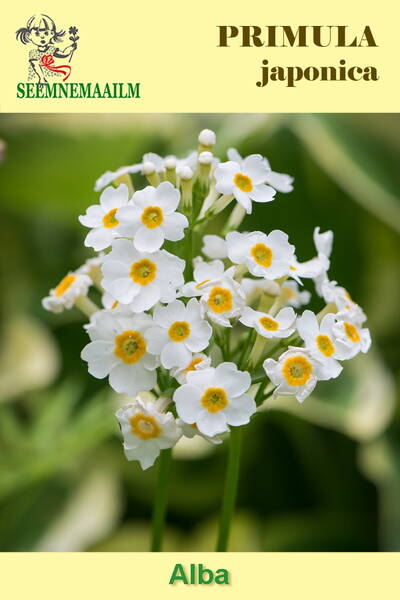A very beautiful and popular candelabra primrose.
A perennial from the Primulaceae family.
Origin: Japan.
Award: Award of Garden Merit (A.G.M.) from the Royal Horticultural Society.
Flower color: white.
Flowering period: May - July.
Plant height: 40-50 cm.
Flower diameter: 2 cm.
Hardiness zones: Z4 - Z8.
Soil requirements: moist.
Use: aquatic or bog plant
1.0 g = 4300 seeds.
It looks beautiful in flower beds and borders, especially in shady parts of the garden where it will feel very comfortable. Can be used for cut flowers.
Sowing: in late April–May directly into the ground in nursery beds, lightly pressed into the soil, or in February-March for seedlings (for more reliable results, the crops are first frozen for 3-4 weeks at temperatures not exceeding -10°C, after which they are placed on a windowsill, shaded from direct sun). Seedlings emerge in 16-18 days. It is necessary to ensure that the soil does not dry out. After the first true leaf appears, the plants are pricked out. They are planted in open ground in May-June, after the threat of frost has passed. Can grow in one place for up to 5 years.
Prefers semi-shaded areas with loose, but sufficiently moist soil, free of weeds.
Care: for prolonged and abundant flowering, plants require timely watering, regular weeding, loosening, and feeding.
In spring, primroses are very demanding of moisture but do not tolerate waterlogging. After flowering, the plant should be fed with a small dose of complete mineral fertilizer. As they grow, add nutrient soil to the roots. Winter-hardy under snow cover, but it is better to cover for the winter with dry tree leaves in a layer of 10-15 cm.
Biological Features: Primrose is a perennial herbaceous plant of the Primrose family (Primulaceae), found everywhere in temperate zones of the Northern Hemisphere. It is a herbaceous plant with dense, wrinkled leaves and large, bell-shaped or funnel-shaped, fragrant flowers of diverse colors. In cultivation, these plants are used mainly for planting in borders or in small groups.
Primroses are sown in spring - early summer. Seeds germinate rather slowly and require moisture for successful germination. Before sowing, the soil is watered, seeds are evenly distributed on the soil surface and lightly moistened with a sprayer. After this, the box is covered with glass or film and placed in a bright location at +15..+20°C. Seeds do not germinate simultaneously, over approximately 10-25 days. The soil surface must be regularly moistened with a sprayer. When 1-2 true leaves appear, the seedlings are pricked out. Germinated seeds often die because their small roots can be pointing upwards. To help them root successfully, the emerged seedlings should be sprinkled with a thin layer of soil and moistened. If you sow seeds in spring, by the end of summer you will get well-developed plants that can be transplanted to a permanent location in early September. The following spring, the first flowers will appear on them, but abundant flowering will occur only a year later.
Primroses bloom for quite a long time (from April until the end of June). Primrose prefers moist soils with the addition of sod land and organic fertilizers (compost, leaf mold, well-rotted manure). For light sandy soils, add 10 kg of compost per 1 m2 during digging. For heavy clay soils, in addition to the specified organic fertilizers, add 1-2 buckets of sand per 1 m2. The soil is cultivated to a depth of 12-17 cm.
Planting: Primroses should be planted so that the plantings are dense, with no open space between the leaf rosettes. The planting distance for small species should be 10-15 cm, and for larger ones - 20-30 cm. The plants are grown for two years, covering them for the winter with a 10 cm layer of leaves. Primroses are planted in their permanent place in the spring or autumn of the second year.
Plant Care: It is necessary to ensure that the soil is always moist and loose, and to remove weeds regularly. In spring, primroses are very demanding of moisture (but at the same time do not tolerate waterlogging). After flowering, it is recommended to water the plants with heavily diluted liquid manure or feed them with a small dose of complete mineral fertilizer (20-30 g/m2).
If primroses are not divided for a long time, they can freeze out. One or two years after planting, nutrient soil can be added to the roots in autumn so that the growing rhizomes do not freeze. To help the plants overwinter well, try to preserve the leaf rosette until late autumn (it serves as natural protection).
Species such as Primula denticulata, Primula vulgaris, and Primula japonica are best covered for the winter with a 10 cm layer of dry tree leaves.
Propagation.
Division of the bush is carried out in early spring or in August - early September. Plants can be divided immediately after flowering, in the 3rd-5th year of cultivation. The bushes are divided into small parts, each consisting of one leaf rosette with a rhizome. After planting, they are watered daily for 2 weeks. Some species (for example, Primula auricula) are propagated by small leaf rosettes, which root well in cold frames or on beds, with mandatory shading. They overwinter there and are planted in a permanent place in spring. Primula denticulata can be propagated by root cuttings. From large specimens, several thick roots are separated; to accelerate bud formation, a longitudinal cut 1-1.5 cm long is made in the upper part of the root. The prepared cuttings are planted in light soil to a depth of 3 cm. Subsequently, they are cared for using standard techniques.












